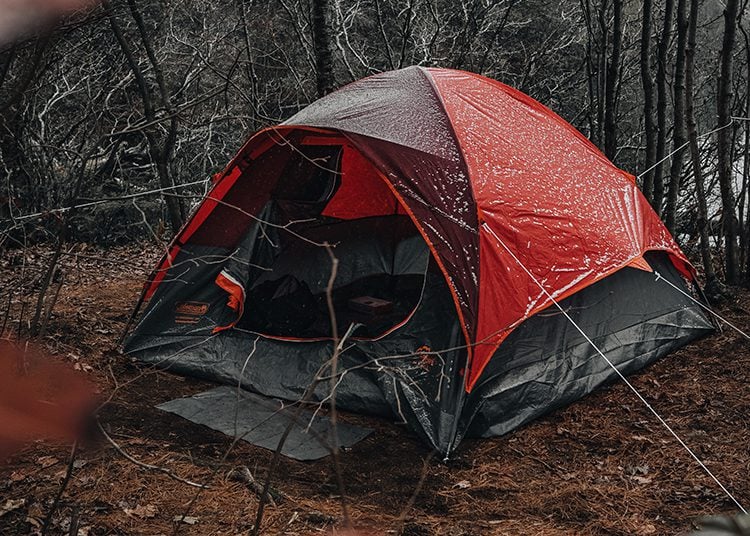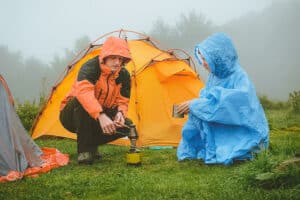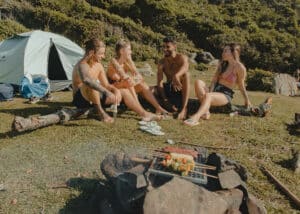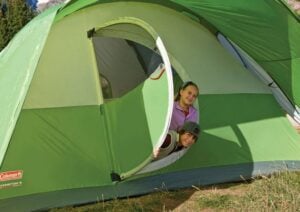If you’re a camping enthusiast, then you probably know there’s more to picking the right tent than just size. In fact, there are several types of tents to choose from, and each one has its own set of benefits and drawbacks.
So how do you decide which one is right for you?
Below we’ll take a look at seven different types of tents, along with a brief description of each one. We’ll also provide some information about what to look for when making your purchase decision.
So whether you’re a first-time camper or an experienced outdoorsman, read on for the inside scoop on the latest and greatest tents on the market today!
Why is understanding the different types of tents important?
Camping enthusiasts should read this blog post so they can understand the types of tents and what to look for when making a purchase decision.
This is important because each type has its own features and benefits, so you will want to pick one that meets your needs the best!
What are the different types of tents?
There are seven types of tents that you should consider for your next camping trip: Instant Popup tents, dome tents, a-frame tents, Screen house tents, Tunnel tent tents, cabin tents, and teepee tents. Each type has its own set of benefits and drawbacks, so it’s important to choose the one that best meets your needs.
🏆 The 7 types of tents you should consider
Camping tents come in all shapes and sizes. It can be difficult to figure out which one is right for you. But, before you can choose a camping tent, you need to understand the different types that are available.
In this section, we’ll introduce you to the most common types of camping tents, so you can start narrowing down your options.
1. What is a Dome tent?
The dome tent is one of the most popular types of camping tents, and it’s easy to see why. This type of tent is incredibly versatile, and it can be used in a variety of different situations.

Who a dome tent is perfect for:
They’re perfect for camping trips with friends and family, and they’re also a good option for backpacking trips.
How a dome tent is made:
Dome tents are typically constructed from nylon or polyester, and they come in a variety of different sizes.
✅ Pros of a dome tent:
It’s incredibly easy to set up. In fact, most of them can be set up in just a few minutes. They’re also relatively lightweight, which makes them a good option for backpackers.
❌ Cons of a dome tent:
They’re not ideal for extreme weather conditions. For example, if you’re camping in sub-zero temperatures, the walls of this type of tent can sag at night, which means you may end up with less insulation than you’d like.
2. What is a cabin tent?
Cabin tents are the perfect solution for those who need a lot of space. In fact, cabin tents can be home to as many as ten people. It’s easy to see why this type of tent is so popular with families and large groups.

How a cabin tent is made:
Cabin tents are typically constructed from nylon or polyester, and they range in size.
✅ Pros of a cabin tent:
It offers a lot of headroom. This makes it comfortable for everyone in the family. Another advantage is that cabin tents are incredibly versatile, and there are few situations they can’t be used in.
❌ Cons of a cabin tent:
They tend to be on the heavier side. This means that they aren’t ideal for backpacking or hiking trips. Cabin tents are perfect for car camping trips, or if you have a truck that can carry them.
3. What is a Pop up tent?
The pop-up tent is one of the most convenient types of camping tents on the market. These fast-pitch tents are incredibly easy to set up, and they’re also lightweight. If you’ve ever set up a dome tent before, setting up a pop-up tent will be a breeze.
Who pop up tents are for:
These tents are perfect for backpacking, and they’re lightweight enough that you can take them with you on short camping trips.
How instant pop up tents are made:
Instant pop up tents are typically constructed from polyester, but they can also be made from nylon. They come in a variety of different sizes, and they typically have aluminum poles. The stakes for these types of tents are made from lightweight plastic.
✅ Pros of a pop-up tent:
They typically have large vestibules. This gives you plenty of space to store your gear, so it doesn’t get wet in bad weather conditions. Another advantage of this type of tent is their incredible portability. They’re lightweight enough to carry over your shoulder, which makes them perfect for hiking or backpacking trips.
❌ Cons of a pop-up tent:
They tend to offer less space than cabin tents and dome tents.
4. What is an A-frame tent?
An A-frame tent, or wedge tent, is one of the most affordable types of camping tents on the market. This type of tent is easy to set up, and it’s also lightweight enough that you can carry it with you on hiking or backpacking trips.
Who an A-frame tent is for:
An A-frame tent is perfect for backpackers who need an affordable option that’s also lightweight. They’re ideal for short trips, and they’ll ensure that you have a comfortable place to sleep at night.
How an A-frame tent is made:
A-frame tents are typically constructed from polyester, and they come in a variety of different sizes. The smallest A-frame tent can accommodate two people, while the largest can sleep up to four.
✅ Pros of an A-frame tent:
It’s incredibly easy to assemble. In fact, most A-frame tents can be set up in just a few minutes.
❌ Cons of an A-frame tent:
They don’t offer a lot in terms of privacy. You’ll need to add an extra rain fly to get the privacy that you’d like.
5. What is a Screen tent?
If you want to enjoy the great outdoors without being bothered by bugs, a screen tent is one of your best options.
Who a screen tent is for:
Screen tents are perfect for those who enjoy camping near rivers and lakes. They’re also great for people who simply want to sit outside without being bothered by bugs.
How a screen tent is made:
These tents can be constructed from mesh or polyester panels that zip together to form the walls and roof of the tent. Most screen tents have a zipper door, and they come with an optional floor.
✅ Pros of a screen tent:
The beauty of a screen tent is that all you have to do is find two trees with suitable branches, and you can set it up in just a few minutes. Another advantage of this type of tent is that they’re incredibly affordable, which makes them perfect for camping on a budget.
❌ Cons of a screen tent:
One disadvantage of screen tents is that they aren’t ideal for bad weather conditions. For example, the walls can easily collapse on you in windy conditions.
6. What is a Tunnel tent?
Tunnel tents are ideal for families or people who want more space than a traditional tent can offer. If you’re looking for the most living space possible, this is definitely the type of tent to go with. Tunnel Tents are also incredibly easy to set up, and they don’t take up very much space in your truck.

Who are tunnel tents for:
Tunnel tents don’t take up much room in your truck, which makes them a popular choice for those who camp with an RV. They can sleep up to six people, and they’re ideal for camping trips where you have a lot of gear.
How a tunnel tent is made:
Typically these types of tents have an aluminum frame that’s covered with polyester panels. Some models also come with windows, and they’re incredibly easy to set up.
✅ Pros:
They offer plenty of space for you and your family to sleep comfortably at night. These types of tents are also very sturdy, which gives them an advantage over cabin tents and dome tents in poor weather conditions.
❌ Cons:
One disadvantage of this type of tent is that they aren’t particularly lightweight. If you plan on hiking or backpacking long distances, you’ll need to carry a heavy load.
7. What is a Teepee Tent?
Teepee tents are a lot of fun to use, and they’re very versatile. One advantage of a teepee tent is that you can easily adjust the height of this type of tent’s center pole. This makes them an ideal choice for families, as they have plenty of room to play inside the tent.

Who are teepee tents for:
Teepee tents are perfect for families who want to play indoors. These types of tents are great because they offer plenty of room, and kids love playing inside them.
How a teepee tent is made:
These types of tents have two layers that are connected together with zippers, which makes them easy to set up. The design of a teepee tent is very similar to that of an A-frame, and they’re typically made with canvas or nylon.
✅ Pros:
It’s incredibly easy to set up. In fact, most of them One advantage of this type of tent is that it can accommodate children. Another plus is that you can easily adjust the height of the center pole.
❌ Cons:
One disadvantage of teepee tents is that they aren’t very waterproof. If you plan on camping in rainy conditions, you’ll need to use a tarp or some other type of waterproofing material underneath your tent.
Things You Should Consider When Choosing a Camping Tent
When choosing a camping tent, it’s important to consider a variety of factors. The first factor to consider is how many people you’ll be camping with. Tents come in all different sizes, so you’ll want to choose one that can comfortably accommodate everyone in your group.
Space
The first factor to consider when choosing a camping tent is how much space you’ll need. Tents come in all different sizes, so you’ll want to choose one that can comfortably accommodate everyone in your group.
Cost
The second factor to consider when choosing a camping tent is how much you can afford. Tents come at all different prices, so it’s important to choose one that won’t break the bank. However, if your most important priority is finding a fast-pitch tent, you typically have to pay more for them.
Weather conditions
The third factor to consider when choosing a camping tent is the weather conditions where you’ll be using it. It’s important to choose a tent that offers protection against wind, rain, and other bad weather conditions.
Type of Tent
The fourth factor to consider when choosing a camping tent is the type of tent that you prefer. If you’re looking for a fast-pitch tent, cabin tents are typically the best choice. However, if you’re looking for something that’s lightweight and portable, A-frame tents are usually your best bet.
Number of People
The fifth factor to consider when choosing a camping tent is the number of people that you’ll be camping with. Tents come in all different sizes, so you’ll want to choose one that can comfortably accommodate everyone in your group. However, if you’re camping by yourself or with just one other person, large tents aren’t necessary.
Privacy
The sixth factor to consider when choosing a camping tent is privacy. If you plan on using your tent for other activities besides sleeping, you may want to choose one with tunnels or dividers so that you have more privacy while inside the tent. Check out our best picks for portable pop up privacy tents.
Ease of assembly
The seventh factor to consider when choosing a camping tent is how easy it will be for your friends and family to set up the tent. If you plan on setting up your own tent, this isn’t terribly important. However, if you’re hoping that other people in your group will pitch the tent for you, choose one with shock-corded poles and simple pole sleeves. This will make it much easier for your companions to pitch the tent.
How to choose the best type of tent for any occasion
How to choose the best type of tents for large groups
When camping with a large group, it’s important to choose a tent that can comfortably accommodate everyone. Depending on the proportions of the people you’re camping with, you may need to consider getting a multi-room tent or a tent that’s tall enough for you to stand up in.
Best tents for large groups:
How to choose the best tents for family camping
When camping with a family, it’s important to choose a tent that will accommodate everyone. However, if you only have one or two children, you might not need as large of a tent as other families might need.
Best tents for families:
- Best tents tall enough you can stand in
- Best 2 room tents for camping
- Best extra large family camping tents
- Best dome tents
- Best multi room tents
- Best Privacy tents (for going to the bathroom and to shower)
How to choose the best backpacking tent
When backpacking, weight, and size are incredibly important factors to consider. However, it’s also important to choose a tent that offers adequate protection against weather conditions. The four main types of tents for backpacking include wall tents, pyramid tents, tarp tents, and tarp tent shelters.
If you’re looking for an ultralight shelter option, a wall tent or a pyramid tent are typically the best choices. However, if you’re looking for something that offers increased protection against the elements, tarp tents and tarp tent shelters are usually your best bet.
Best backpacking tents:
- Best 1 person backpacking tent
- Best 2 person backpacking tents
- Best 3 person backpacking tents
- Best 2 person hammock tents
- Best survival tents
- Best tents for wild camping
How to choose the best tents for small groups
When camping with a small group, it’s important to choose a tent that can comfortably accommodate everyone. Depending on the proportions of the people you’re camping with, you may need to consider getting a wide tent or a tent that’s tall enough for you to stand up in.
Best for small groups:
- Best dome tents for camping
- Best 4 person tents for camping
- Best 3 season tents for camping
How to choose the best tents for car camping
If you’re planning on car camping, you’ll have a bit more space to play around with when it comes to choosing the right tent for your trip. You can choose from a variety of types of tents, including wall tents, cabin tents, and dome tents.
How to choose the best tents for easy setup
Whether you’re camping with a large group or just by yourself, choosing the right tent will make setup much easier. If you’re looking for something that can be pitched in under two minutes, it’s typically best to choose a tent that has pre-attached poles and simple pole sleeves (shock-corded poles are usually easiest to use).
Best instant popup tents:
- Best Instant tents for easy set-up camping
- Best pop-up tent for camping
- Best inflatable camping tents
How to choose the best tents for hot weather
If you’re camping in hot/humid weather, it’s important to not only look for a tent that can keep you cool, but also one that will keep your sleeping bag dry. The best type of tent for hot and humid weather typically has high ventilation and is made with breathable material. It’s also important that the rain-fly has good ventilation to keep air flowing through the tent, especially if you’re camping in an area where it might rain.
Best tents for hot weather:
- Best tents for desert camping
- Best 3 season tents for camping
- Best dark rest & blackout tents
- Best tents for burning man
How to choose the best tents for winter weather
When camping in cold weather, it’s important to look for a tent that can protect you from the elements and help keep you warm. Whether you’re planning on camping at higher elevations where it gets colder or somewhere with harsh winds, it’s important to choose a tent that has strong poles and walls. Most four-season tents are best suited for winter camping because they’re built to withstand the elements.
Best tents for winter weather:
How to choose the best tents for rainy weather
If you’re camping in a location where it might rain, it’s important to make sure your tent is properly waterproofed and has good ventilation. In addition to being able to repel water, the best tents for rainy weather typically have polyurethane-coated floors that can handle damp conditions.
Best tents for rain rain:
The Components of a Tent
Tent body
The body of a tent is the most important part of the tent. It’s what protects you from the elements and keeps you warm and dry. The best tents are made with waterproof and breathable material, which allows water to escape while keeping rain and wind out. A tent body is typically made in either nylon or polyester.
Some of the most common materials used in tent bodies are:
- Polyester: A versatile, fast-drying synthetic material that is strong and lightweight.
- Nylon: A waterproof and abrasion-resistant material with a durable finish that’s available in a variety of weights depending on conditions. Polyester nylon is very breathable but not as durable as other materials.
- Cotton: An absorbent and heavy material with a low strength-to-weight ratio that becomes very stiff when wet.
- Silnylon: A waterproof and lightweight material made from silicon-coated nylon that’s very durable.
Tent poles
The importance of tent poles can’t be overstated when it comes to camping trips. They provide the necessary support for the tent body, and if they’re not made well, the entire tent can collapse. Most good tents come with shock-corded poles, which are easy to set up and don’t require any special tools.
The different types of common tent poles are:
- Shock-corded poles: a type of tent pole that is easy to set up and doesn’t require any special tools. Most good tents come with shock-corded poles, which are made from a lightweight and strong metal that is corrosion-resistant.
- Aluminum Poles: A lightweight and strong metal that is corrosion-resistant.
- Fiberglass Poles: A strong and lightweight material that make flexible poles and is prone to breaking.
- Steel Poles: A strong and heavy metal that is rust-resistant but can be difficult to set up.
Tent stakes
Tent stakes are important for two reasons: they help secure the tent to the ground, and they also serve as anchors for the tent poles. If the stakes are not in place, the wind can easily blow the tent away, and the poles can fall down. Make sure you use enough stakes to keep the tent firmly in place.
Tent fly
The fly is a secondary layer of protection that goes over the tent body. It’s typically made from a waterproof and breathable material, and it helps keep rain and wind out while allowing water to escape. The fly is also important for ventilation, as it allows air to flow in and out of the tent. Without good ventilation, the inside of the tent can become hot and humid very quickly.
Guy lines
The tent fly is held up in place with adjustable guy lines. These ropes help keep the tent cover in position and prevent it from blowing away in strong winds. Make sure you secure your guy lines well, as they can come loose easily when exposed to heavy winds.
Tent bag
The tent bag is designed to protect the tent or tarp when it’s not in use. The best tent bags are made with durable material and strong seams that can resist water, so they should be able to keep your gear dry at all times.
What should I look for when buying a new camping tent?
When choosing among the many types of tents available for purchase, first consider what kind of weather conditions you’ll likely encounter during your outdoor adventures.
You don’t need anything too heavy-duty if you typically camp in warm, dry climates for example. Also make sure to check out how easy it is to set up your new purchase if there are any extra features that will be helpful on your trips (such as pockets or storage space), and how well-ventilated the structure is.
Make sure you’re able to test it out (or at least check the stitching) before buying online to ensure it’ll stand up against rain and wind.
Where should I pitch my tent?
While most people use their tents on grassy areas, make sure not to pitch them too close to trees because falling branches can cause serious injuries during bad weather (when they’re wet).
Aside from keeping the structure away from other hazards, being careful not to set it up too close to other people or campsites is a good idea because it can disturb their rest and you don’t want your tent to get in the way of emergency vehicles if anything goes wrong.
How do I keep my tent clean?
Washing your tent with soap and water will usually do the trick especially if it still has dirt stains from your last camping trip.
If your tent is made from a breathable material, you can try using a gentle fabric cleaner to get rid of dirt and grime because it won’t block the pores and make the material less effective against rain and wind.
Our recommendation on the best type of tent for general use
If you’re looking for a general all-purpose tent that can be used for a variety of different camping trips, we recommend checking out our selection of the best dome tents.
Dome tents are versatile and typically easy to set up, making them a good choice for beginner campers. They also come in a variety of different sizes, so you can choose one that’s best suited for your needs.
Frequently Asked Questions about Tents
Is a dome tent the same as a regular tent?
A dome tent is just one type of many that you can choose from, but it’s typically considered to be another name for a regular tent. In other words, they’re both tents that have a circular shape and are meant to sleep, multiple people.
Do I need a camping permit in order to pitch my own tent?
Some national forests or state parks might require you to have a camping permit before pitching your own camp on their land. It’s best to check with local rangers first if this is an issue where you’ll be going. You can also pitch your new purchase on your own property or at designated sites for free.
In what kind of weather conditions should I bring my tent?
While all tents are designed to protect campers from rain and wind, they’re not always able to do that in extreme weather. If it’s expected to be very hot or cold during your trip, you may need to take extra precautions such as bringing a canopy for shade or buying a better-insulated sleeping pad. Also, make sure your tent is well away from trees because falling branches can cause serious injuries.
What’s a decent price for a new camping tent?
You can expect most quality tents that are meant for one or two campers to cost hundreds of dollars. If that sounds like more than you’re willing to spend, be on the lookout for sales at local retailers and online stores. Also, check out our guide on how much you should really pay for a new backpack.
How do I store my camping gear?
Most people like to fold their tents and other accessories into their original bags as soon as they’re brought back inside (after cleaning them first). You could also use storage bins or duffel bags for larger pieces such as sleeping pads, air pumps, etc. It’s best to keep all your gear out of direct sunlight so it won’t be damaged by high heat levels.
Recap and Further Reading
It’s important to consider the size and number of people you’ll be camping with when choosing a tent. Keep an eye out for tents that have high ventilation, polyurethane-coated floors, and poles made from strong materials such as aluminum.
Although they’re typically more expensive, dome tents are a good choice for general use. They come in a variety of different sizes and shapes, and they can be used with or without a tent fly. Also, make sure to check out our guide on how to pack for your next camping trip and what items you should always take with you.
Thank you for checking out the article, we hope that it has been helpful! We’re happy to provide additional information or answer any questions. If you would like to get in touch with us please leave a comment below.





